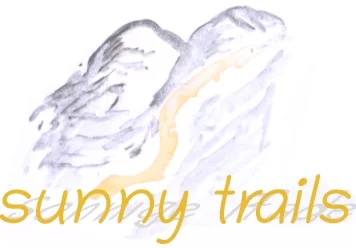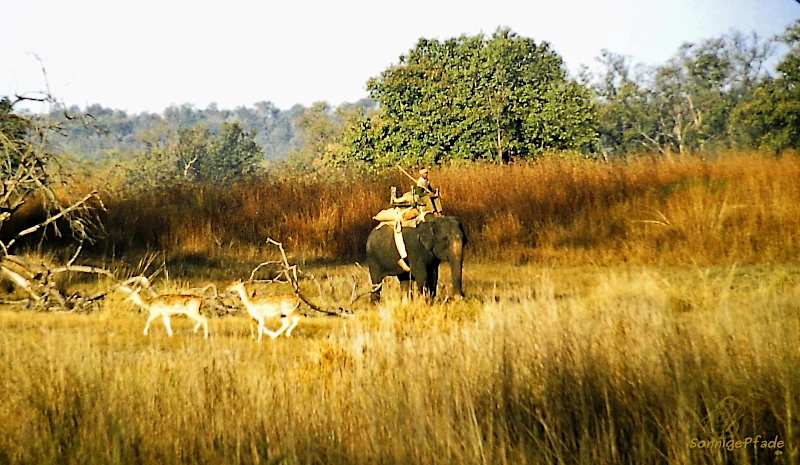
In the Indian Kanha National Park
A travel story – first published in german
From Puna the journey goes through central India – first by train to Nagpur. To „conquer“ the place on a gangway couch was not at all easy. We only had „waiting-list“ – tickets, so without seat – reservation. That means the train is basically overbooked and all seats sold. But once the conductor has agreed that you can stay seated, there is a good chance to get some real seats. Otherwise you might not even get your money back. Our destination is the Kanha tiger reserve in Madhia Pradesh.
The trip took about 17 hours. This is quite normal in India, the distances are infinitely greater than in Germany and in addition the trains do not reach express speeds.
From Nagpur there is a Sleeper – Bus to Jabalpur. That means, the interior consists of a kind of snoring shelf. Boxes, in which you can put you and your luggage. By this way, one survives the night drives more or less lying down. But due to the low height, sitting down is not possible. At some time, the back starts to hurt.
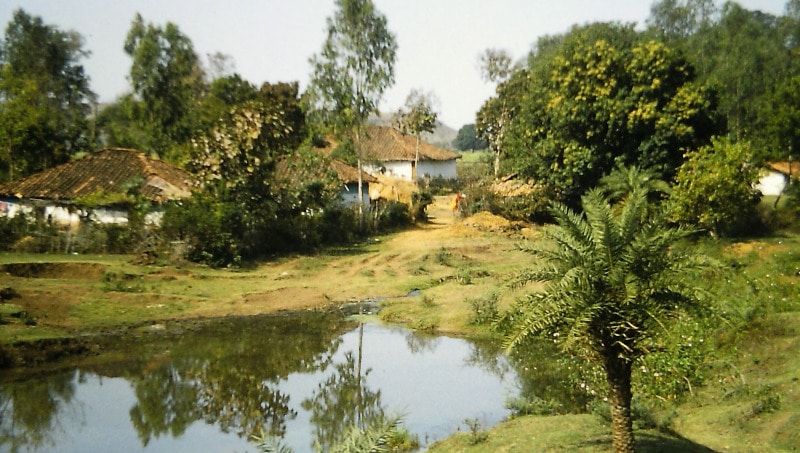
But we still haven’t reached our destination – another bus takes us for hours and roads, which are more like dirt roads, to the village Kathia. This village is located at the edge of the Kanha National Park in Madhya Pradesh, our destination. The landscape outside is getting more and more beautiful and varied – much more green, whole forests, in between also some clayey waters. And also the villages look quite „healthy“ – the houses are in order, smiling people in colourful dresses are everywhere.
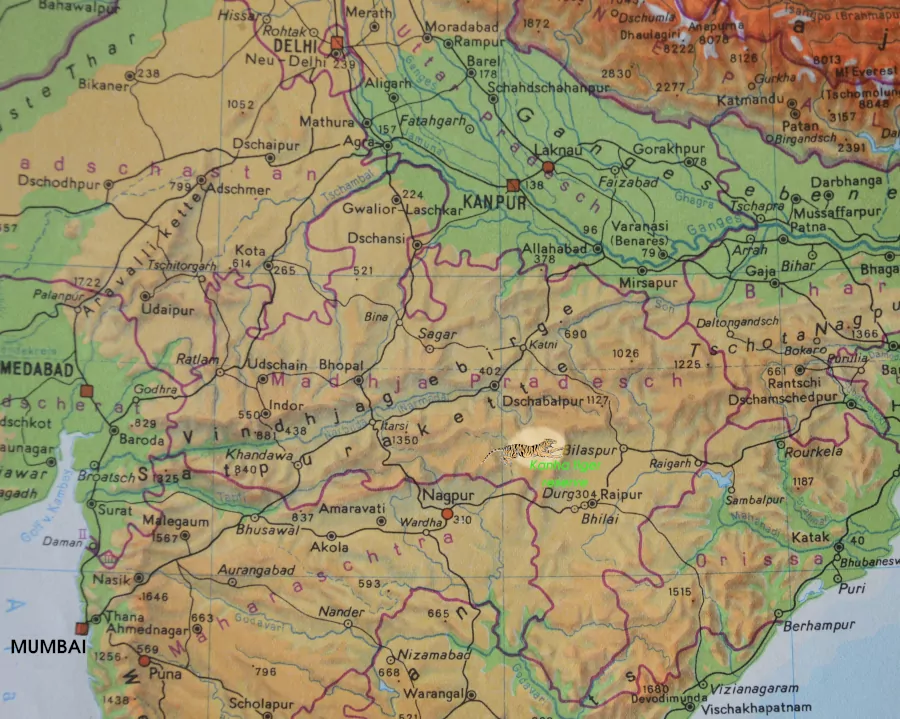
We are lucky – in the bus to Kathia we get to know Bafathi. He speaks to us – we are conspicuous as „white noses“ and he asks where we want to go. He is at home in Kathia and knows the national park very well. A kind of reference book shows photos of him and many other travellers he has driven and guided in the Kanha national park, and many very enthusiastic testimonials about it.
We promise to stay in contact.
When the bus arrives in Kathia, I first need a toilet after the long journey. One of the men leads me around the corner between the houses and points to two bricks lying parallel to each other. Welcome to the country.
The bus stop is located directly at the „pub mile“ of Kathia. Anyway, there is a row of houses here with open fronts, in front of them always some tables and chairs, sometimes under sunshades, sometimes something like a pergola made of bamboo poles. Here one gets something to eat and also the overnight stay is quickly arranged.
A few steps into the Kathia village we get a room with side entrance at the front of a mud house. Modest, but for us very well in order. And cleaner than some of the „on the way-hotels“ were before. We put in our luggage and walk back to one of the restaurants. Here it gets really dark, in February of course also very early, i.e. without a flashlight you hardly have a chance to find your way back. There are no street lights in the villages and the lamps of the restaurants only light up a small place at the „main street“, only the moon is clear and bright over the country.
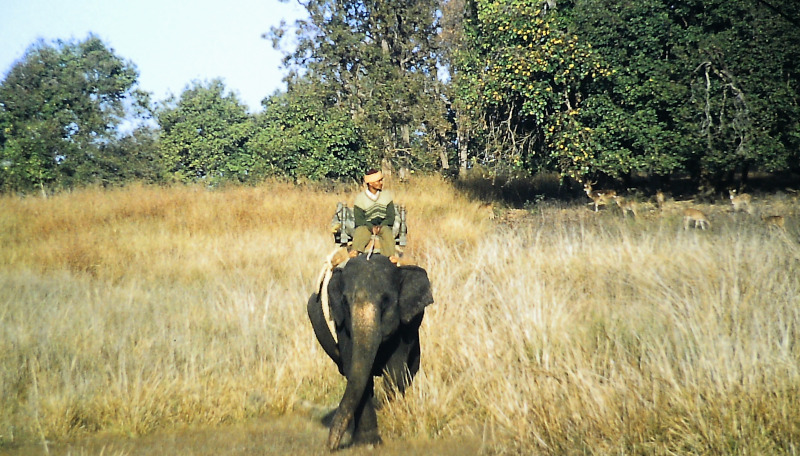
To get into the Kanha National Park, you will need to organise a jeep and driver or join others who have already done so. In addition you have to pay an entrance fee for the tiger reserve and the fee for a park ranger, who has to ride on each of the jeeps. That adds up quite nicely, even if a part of the costs can be apportioned to all passengers. But if this money is really used for the protection of the Kanha tiger reserve, that is ok. Bafathi is such a jeep driver. For the next day we can climb up with him, together with a British couple and a Frenchman, who is travelling alone.
The night out here in the country is unusually cold, quite different from what we are used to. I need the whole sleeping bag with move-in and I am happy that there is a blanket on the bed.
Early we start already at 6. It is still pitch dark. The national park opens its gates at 6:30 a.m. (this is to be taken literally) and then it is allowed to be there until 12:00 noon. So shortly after 6 a long queue of jeeps forms in front of the entrance to the Kanha tiger reserve.
The park fees are collected and the rangers get in. Our ranger seems not to be completely happy to have to drive with Bafathi. Later it slowly shows why. Bafathi is the real leader here. He knows his way around very well, his head flies to and fro, his eyes seldom go on the trail. Eyes and ears search the bushes and trees of the surroundings and capture his full attention. The official ranger, on the other hand, seems to be only half on the job. He has no chance against a freak like Bafathi.
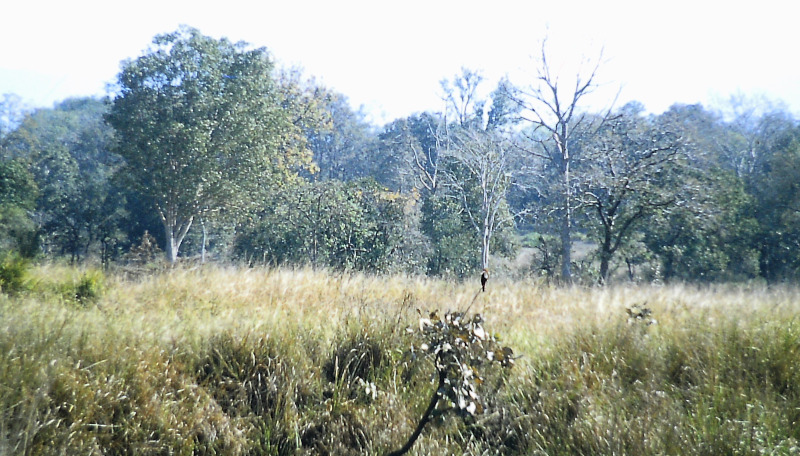
Even now it is still freezing cold and in the west the huge moon stands over the landscape. In the east the reddish dawn is dawning. For the first time in India I am glad to have mountain boots, sweater and jacket with me and even these are not quite enough in the morning chill. In the brown, wiry meadows different animals stand together in herds. Deer and stag species like Sambar deer and Barasingha, but also Gaur – India’s largest wild buffalo – graze peacefully in the rising morning sun and are not disturbed by the jeeps of the „safari“.
The two British are really in hunting fever, also Bafathi late attentive in all directions. I like to let myself be infected by it.
A single elephant grazes between high rushes. After a long drive, Bafathi suddenly stops and sets back a bit. He draws our attention to a scratch mark on the side of the road, which is said to be from a tiger. This seems a bit staged to us.
On a wide hilly meadow we meet two mahouts, park rangers, who are combing the rushes with their elephants. Recently a tiger is said to have been sighted here. They are now roaming through the meadows trying to flush him out and drive the jeep tourist in front of the cameras. But for the time being there is no success, the tiger is hiding.
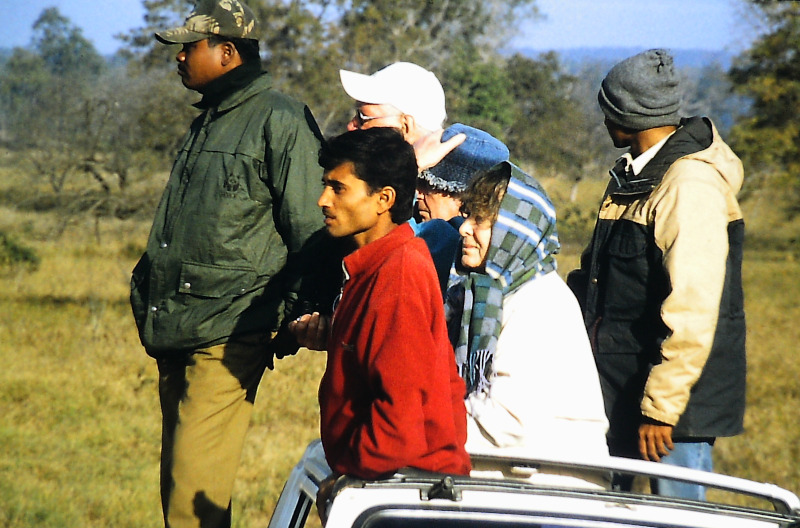
A few minutes pass, more and more jeeps converge in this area. The jeeps have moved to new positions at a change. Bafathi listens in a certain direction and excitedly draws our attention to the „alarm-calls“ of the langurs – the monkeys indicate that a tiger is nearby. Bafathi and the guide from the national park stare into the bamboo thicket. They try to anticipate the path of the tiger and the jeep rolls a few meters further. Tight crowd – all other vehicles follow the narrow path. They are more likely to be guided by Bafathi’s reputation as a legendary tiger „hunter“ and his instinct than by their own observation.
We squat on the platform. Catching our breath, the cameras at the ready, tense attention, no whispering disturbs the silence.
And then from the left the tiger actually steps out of the bushes and calmly crosses the path in front of our jeep to disappear on the other side between bamboo poles. Only a few seconds – for many the fulfillment of the day, for some even of a life dream.
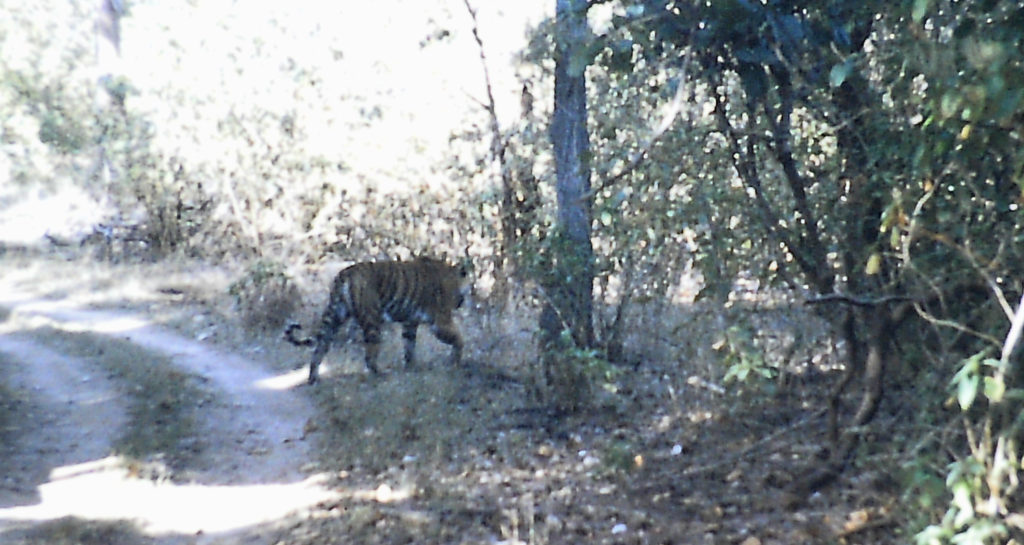
At a new position, at another crossroads with the Tiger Trail, success is not forthcoming despite a long wait. Obviously the kitten has laid down for a morning nap after the stress before.
Even later we see a number of exotic animals on the tour of several hours until noon – twenty minutes of attention is only given to a „paradise flycatcher„, a white bird with a long „flycatcher“ – tail. Also the ranger has arranged himself in the meantime and participates more eagerly in the observation.
At noon we sit with „our jeep crew“ in one of the small restaurants in Kathia under the shade roof and drink Tschai, eat Thali and chat about the experiences of the morning.
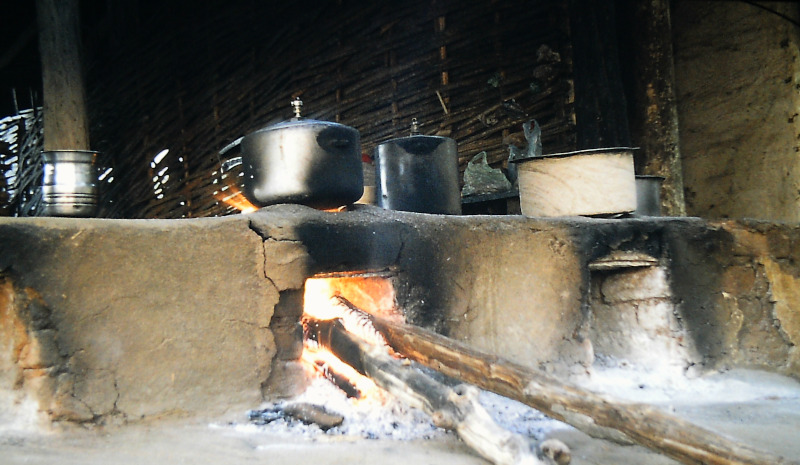
These street restaurants in Kathia are funny. One next to the other they consist of a kitchen built of clay, the stove is an open fire hole, is fired from the outside with long logs and branches and at the same time forms the separation between the kitchen area and the guest tables at the street. The chef’s are old, wrinkled men who look as if they have worked in the fields for years before the national park brought tourists and thus a new source of income. They include more or less many younger employees – probably a large part of the male family members, at least one of whom then speaks little English and takes on the „waiter role“.
It always takes forever before the food is on the table. After the order and some time of ‚devotional silence‘, potatoes are peeled, cauliflower is washed, onions are diced, before everything is steamed one after the other on the only fireplace. This is disturbing and not at all. It is very relaxing and at the same time interesting to sit in the shade, have a drink and listen to the stories that the various travellers bring to the table. After all, all those who have made the long and uncomfortable way out here are strong nature lovers and „earthy“ people. At the same time important information and tips are exchanged…
Since five of us can start again – everybody wants to start again – we decide to use the afternoon opening of the Kanha national park together. From 4 o’clock on the park is open for another 2 hours. But this second safari is more exhausting. The heat is still oppressive and we do not see as many animals as in the morning. I can also observe deer at home, which are moving in large herds – where they look around suspiciously and flee at the slightest sign of danger – here they somehow stand guilelessly on the rushes and hardly move from the spot.
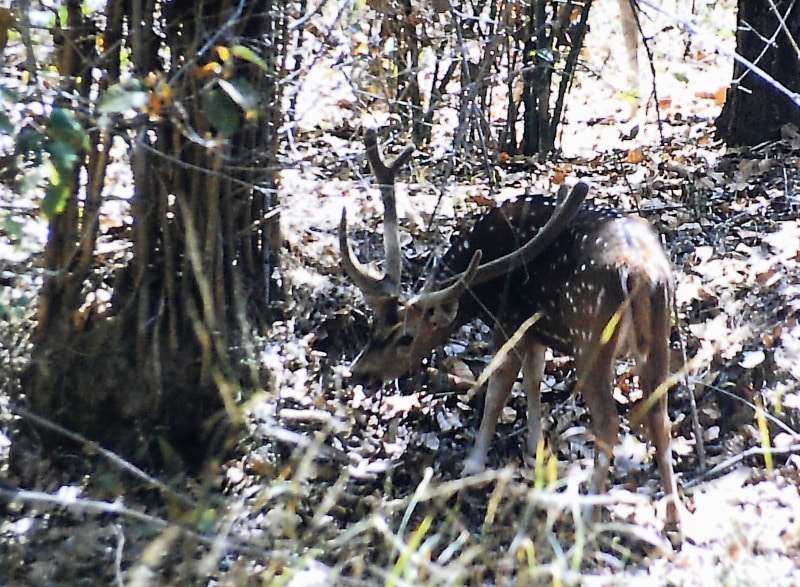
The next morning I washed my trousers and my T-shirt. Such a long bus tour leaves traces. The windows are all open, only with bars, the streets are dusty, a thick layer of dust blows in. Usually I wash a set in the sink every few days and use the „second equipment“.
After breakfast we went on foot on the lateral path near the Kanha tiger reserve, which leads over 11km along the edge of the national park. That was a nice walk, very quiet. Partly we crossed dry creeks, once even a dried up riverbed. Termite mounds stand in the light deciduous forest. Several times we saw Sambar deer, many monkeys, the most „exciting“ was a small snake hanging quite high up on an iron observation tower.
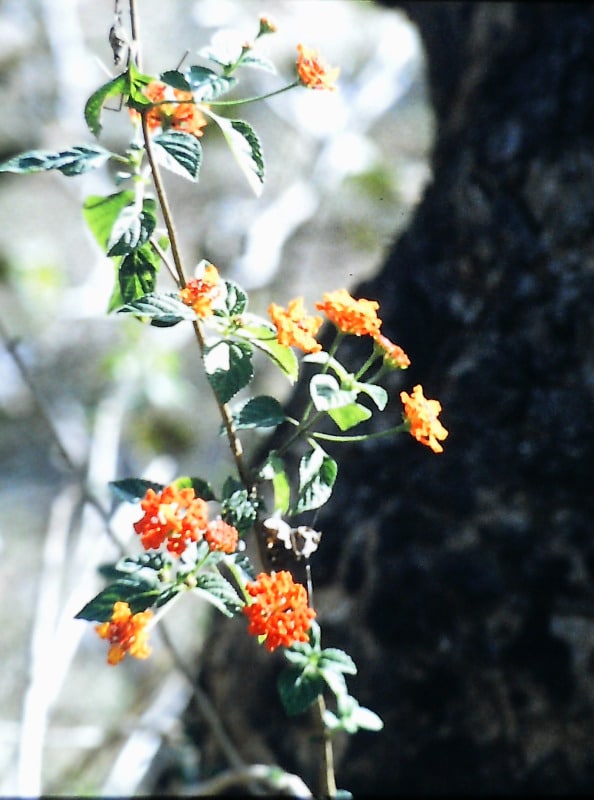
In a settlement I bought myself a cloth, which now serves me as head protection and cleaning. Then we stopped at a small tea-room, where otherwise only locals go. In front of it stood their heavy iron bicycles.
Back in Kathia, for dinner we are invited to another restaurant this time – a boy, about 12 years old, approaches me. You can’t really call it a restaurant. Under a round roof his mother prepares Thali. For cold drinks the boy quickly scurries across the street to the traders on the other side. They only get paid when we have settled the bill.
We sit on a bench at the edge, the boy asks for our order in English and is visibly proud that he can do that. His mother speaks only Hindi and sits on the floor to peel potatoes and dice onions. The fireplace is right next to it, we can watch her baking Roti in the embers.
From time to time other Indians pass by, says the „art dealer“ from the shop on the same farm. That seems to be the boy’s grandfather. The father works somewhere far away. That is not uncommon in India – there are many migrant workers who commute between several places during the season and work as day labourers.
We feel really taken in, more like in a family than in a restaurant. It tastes great! The boy writes the bill by hand on a tiny piece of paper. His mother rewards him with admiring glances. Happily, full and satisfied we say goodbye.
I visit our „safari crew“ once again, who are sitting across the street in the „regular restaurant“. They didn’t get to see a tiger today, only hear several of them roaring loudly. The Frenchman and a West German from Freiburg advertise me very intensively to come along again tomorrow – without sharing the costs, the whole thing is quite an expensive pleasure. But my demand is saturated for the time being and we want to travel on the next morning.

Before departure we all meet again. Bafathi is also there and is happy to see us again. The Frenchman was probably very lucky in the morning, they were able to observe and photograph a tiger for several minutes.
Then we climb into the bus and leave Kathia. India still has many secrets to reveal.
Good story?
Did you like that story about the safari in the Kanha tiger reserve? Then share the link to the post in your „social media“! Thanks!
